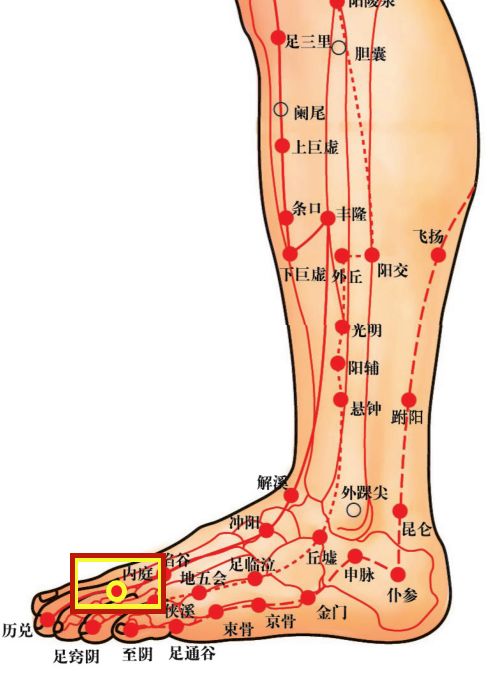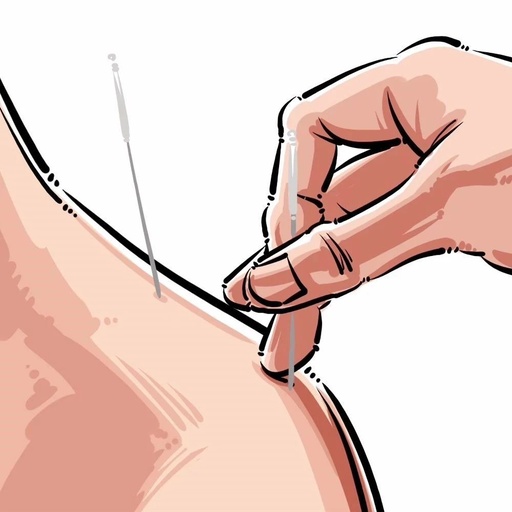Warm Reminder
This section aims to introduce the basic knowledge of acupoints in the human body, providing a fundamental understanding of them and a simple overview of their application in external therapies such as moxibustion, cupping, and guasha. Many acupoints have high risks associated with needling; non-professionals in acupuncture should not attempt needling operations!
The Stomach Meridian of the Twelve Meridians
🔹 Meridian Pathway
This meridian starts at the side of the nostril (Yingxiang point), ascends along the nose, intersects at the root of the nose, and enters the inner canthus of the eye, intersecting with the Foot Taiyang Meridian. It then descends along the lateral side of the nose, enters the upper teeth, exits, runs alongside the mouth, encircles the lips, intersects at the Chengjiang point in the mentolabial groove, returns along the lower jaw bone to the Daying point, ascends along the angle of the jaw, passes in front of the ear, goes through the Shangguan point (Guest Master), along the hairline, and reaches the forehead.
This meridian has a branch that descends from the front of the Daying point to the Renying point, travels down the throat to the Dazhui, bends forward, enters the Jueyin, descends through the diaphragm, belongs to the stomach, and connects to the spleen. A straight branch exits from the Jueyin to the surface, descends along the midline of the breast, runs alongside the navel (two inches lateral), and descends to the Qijie point outside the groin. Another branch exits from the pylorus of the stomach, descends within the abdominal cavity to the Qijie point, joins the straight branch, and then descends along the front of the thigh to the knee, along the anterior edge of the tibia to the dorsum of the foot, entering the lateral side of the second toe (Lidui point). Another branch exits from three inches below the knee (Zusanli point), descending to the lateral side of the middle toe. Yet another branch exits from the Shangyang point on the dorsum of the foot, moving forward to the medial side of the big toe (Yinbai point), intersecting with the Foot Taiyin Spleen Meridian.

🔹 Summary of Indications
This meridian’s acupoints are indicated for intestinal sounds, abdominal distension, abdominal pain, stomach pain, ascites, vomiting or excessive hunger, thirst, sore throat, epistaxis, and pain in the chest and knee areas along the meridian pathway, as well as febrile diseases and mania.
Acupoint of the Stomach Meridian
🔹 Neiting (Xing point)
[Source] “Lingshu: Ben Shu”
[Location] On the dorsum of the foot, at the depression in front of the junction of the 2nd and 3rd metatarsals.
[Needling Method] Sit upright, locate the depression slightly posterior (about half a transverse fingerbreadth) at the midpoint of the web between the 2nd and 3rd toes, pressing until a sour and distended sensation is felt.

[Indications]
-
Toothache, sore throat, epistaxis, and other heat-related diseases of the five sense organs;
-
Febrile diseases;
-
Acid reflux, diarrhea, dysentery, constipation, and other gastrointestinal diseases;
-
Swelling and pain on the dorsum of the foot, pain in the metatarsophalangeal joints.
[Application]
The Neiting point is the Xing point of the Stomach Meridian, where “Xing” means to enter; “Ting” refers to the entrance. The Neiting point is located at the end of the web between the 2nd and 3rd toes. The toe web is like a door, symbolizing the acupoint at the entrance, hence the name Neiting point. When locating the point, sit with feet hanging down or lie supine, pressing on the skin at the web between the 2nd and 3rd toes until a significant sour pain is felt, indicating the acupoint.
The Neiting point is a specific acupoint for treating tooth pain. One of the most notable features of the Neiting point is its ability to drain stomach fire, effectively clearing heat and stomach fire. The Neiting point is the Xing point of the Stomach Meridian, and “Xing” is particularly good at treating heat syndromes. It is especially effective for tooth pain caused by stomach fire. Any tooth pain, sore throat, acid reflux, halitosis, epistaxis, or constipation caused by stomach fire can be treated by stimulating and massaging the Neiting point. Conditions such as sore throat and epistaxis due to excessive stomach fire, as well as acid reflux, diarrhea, dysentery, and constipation caused by gastroenteritis, fall within the treatment scope of the Neiting point.
Generally speaking, halitosis, acid reflux, and constipation are often caused by stomach fire. Zhu Danxi in “Jufang Fahui” pointed out: “Usually, the body fluids accumulate due to the rising Qi, and if stagnant for a long time, it generates heat, which transforms into fire, leading to sour taste; what else could it be but heat?” This means that body fluids accumulate and generate heat due to prolonged stagnation, which eventually transforms into fire, causing sour taste in the mouth. Halitosis and constipation also indicate the presence of stomach fire. If you experience halitosis, acid reflux, and constipation simultaneously, it can be confirmed that there is stomach fire. In this case, needling the Neiting point can have a good fire-draining effect.
Massage Technique: Use the fingertip to press the Neiting point for 2-3 minutes; long-term massage can improve halitosis and abdominal distension. Place one thumb on the opposite Neiting point and apply appropriate upward and downward pressure to reduce swelling and relieve pain. This can treat symptoms of oral ulcers, epistaxis, and other heat-related conditions. Additionally, massaging the Laogong point together with the Neiting point enhances the effect. The Laogong point is a key point on the Hand Jueyin Pericardium Meridian, located between the 2nd and 3rd metacarpals in the palm; when making a fist, the tip of the middle finger points to this location. Its ability to clear heat and eliminate halitosis is due to it being the Xing point of the Pericardium Meridian, thus also having the function of clearing heat and draining fire. In clinical practice, I often use it to treat oral ulcers and halitosis caused by internal heat, with outstanding results.
Use moxa sticks to gently moxibust the Neiting point for 5-10 minutes once a day to treat abdominal distension and pain, as well as tinnitus.
[Literature]
“Lingshu: Ben Shu”: “Next to the outer space of the finger.”
“Introduction to Medicine”: “At the junction of the second and third toes, in the middle of the metatarsal bones.”
“Collection of Acupuncture Prescriptions”: “Three fen behind the two metatarsals.”
“Acupuncture Collection”: “At the end of the toe lines.”
*Acupoint images are from the book “Illustrated Huangdi Neijing” published by Zitu Publishing.
Cover | Eight Years Old
Editor | Yuan Li

